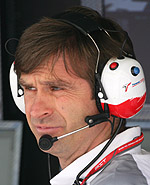 Looking ahead to Malaysia, what are the main considerations?
Looking ahead to Malaysia, what are the main considerations?
Pascal Vasselon – Senior General Manager Chassis: Sepang is an interesting track because it’s hard for every single component of the car. It’s hard on the tyres because of the temperatures and the surface, which is quite rough. It’s hard on the cooling package and the brakes and it’s demanding in terms of set-up because you have slow corners and high-speed corners. What is especially interesting at the start of the season is that Malaysia helps us understand the nature of the main performance issues. What I mean by that is that normally you have two main factors in terms of performance – aerodynamics and tyres. At the start of the season there are always question marks about the warming up of tyres and their temperature range. That’s because in winter testing we run in lower temperatures than the tyres are designed for. Melbourne is also a place where, historically, the tyre warm-up is difficult because it’s never that hot and the surface is quite smooth. Sepang is therefore the first race that really tells you how the car behaves without warming up issues. When you go there you know that the tyres will work so you get a better idea of the total performance package.
What car developments are planned?
PV: We have a major update planned for race four, Barcelona, and then, as is normal now, we will have small upgrades at each race.
How would you assess Toyota’s performance in Australia?
PV: Overall I think it has been just acceptable and Ralf scored point. We did have one or two issues. Ralf had a gearbox control problem in qualifying when the engine stuck in first gear but it was easy to fix by resetting the software. Then there was Jarno leaving the pits with the trolley attached, after which we reviewed our procedure for releasing the car from the pits. In the race Jarno was unfortunate with the traffic and then had some brake problems.
Did Australia follow the pattern you expected after winter testing?
PV: We are not where we want to be in terms of performance because we are aiming to challenge the top teams, but on the other hand our level was better than the general assessment before we went to Melbourne. We know where we are now and can fight to close the gap to the top teams.
Was the tyre choice clear cut in Australia?
PV: It was clear cut in the sense that there were two tyre types and the rules say we now have to use both in the race! What still needs some thought is how you use them. The first decision in Melbourne was an easy one – most teams used the soft tyre in qualifying. We knew that the same tyre was struggling a little on longer runs and so, as you saw, most teams used the medium compound tyre for the longer first stints and the softer one for the shorter final stint.
Will this vary from race to race depending on the circuit?
PV: Exactly. At some circuits we already know that the two specifications will both be competitive and so it will be down to subtle differences as to when and where you use the option tyre. In Australia it wasn’t subtle, there was quite a big difference. If the rules were not as they are, nobody would have run the soft tyre in the race in Melbourne.
What operational differences do the 2007 rules make to an F1 race weekend?
PV: The obvious difference is that this season we can prepare much better for the race because two of the most important limitations we had last year are gone. We have no concern anymore with engine mileage because we run a different engine on Friday. The race weekend from an engine point of view is now just Saturday and Sunday, so the mileage target is a lot easier to achieve. The tyre limitation has also gone. We don’t have a lot of tyres but we have enough. We have four sets of tyres on Friday, two other sets that we have to use in Saturday morning practice and then eight sets of tyres left for the race. We can therefore better evaluate the tyre degradation and conduct the set-up work. The race preparation is much more thorough than last year when we were always trying to avoid engine mileage and tyre usage.
Do you think the new rules are more compatible with what F1 should be?
PV: For engineers it is a much more satisfying approach simply because we can go through the preparation in much more detail.
And surely it makes more sense for the fans, too?
PV: Definitely, because you see many more cars on the track and the practice sessions are more action packed.

 Looking ahead to Malaysia, what are the main considerations?
Looking ahead to Malaysia, what are the main considerations?


















